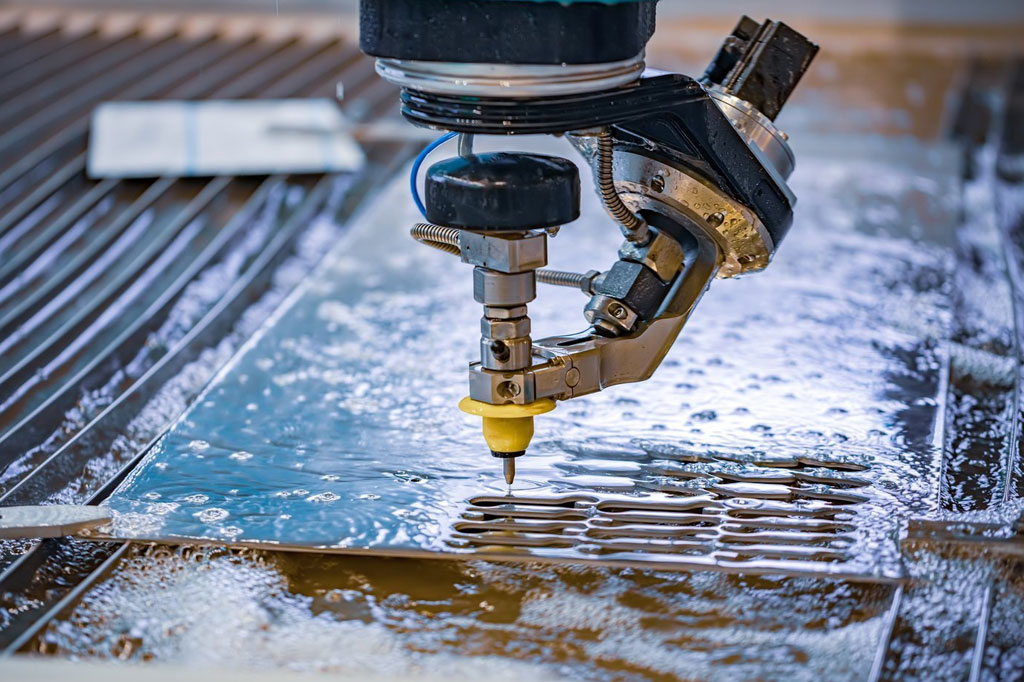Waterjet cutting is a popular and versatile technique used for precision cutting across a wide range of materials, from metals and ceramics to plastics and glass. Although waterjet cutting offers numerous benefits, it can also present some challenges during the cutting process.
In this article, we will discuss common waterjet cutting problems and their solutions, helping you to optimize your processes and achieve the best possible results.
1. Tapered Cuts
A tapered cut occurs when the cut edges are not perfectly vertical. This can create an angled cut in the material, potentially impacting the final part’s quality.
Possible Causes:
- Incorrect nozzle alignment or worn nozzle
- High cutting pressure
- Excessive cutting speed
- Improper standoff distance (the distance between the nozzle and the material)
Solutions:
- Adjust nozzle alignment: Make sure the nozzle is correctly positioned and fully functional. Replace worn nozzles to prevent tapering.
- Optimize cutting speed: Reduce the cutting speed for thicker materials to minimize tapering.
- Maintain proper standoff distance: Adjust the nozzle height to maintain a consistent standoff distance during cutting. This ensures the waterjet stream remains perpendicular to the material.
2. Edge Rounding
Edge rounding occurs when the cut edges become rounded instead of sharp, affecting the dimensional accuracy of the part. This is particularly noticeable in thick materials and can be problematic for tight tolerances.
Possible Causes:
- High abrasive flow rate
- Incorrect focus of the waterjet stream
- Inconsistent material thickness
Solutions:
- Lower abrasive flow rate: Reducing the abrasive flow rate can help achieve sharper edges by limiting the effect of the abrasive on the material.
- Adjust stream focus: Ensure the waterjet stream is focused properly. A well-focused stream will produce a clean, sharp cut.
- Consistent material thickness: Regularly check the material thickness for consistency. Variations in thickness can lead to edge rounding, particularly with thicker materials.
3. Burring and Deburring
Burrs are raised edges or material that sticks to the cut part after waterjet cutting. This can result from abrasive particles or a rough cutting surface.
Possible Causes:
- Incorrect abrasive material choice
- Poor cutting parameters (speed, pressure, and abrasive flow rate)
- Material type and thickness
Solutions:
- Use the right abrasive: Ensure you are using the proper abrasive for the material being cut. For example, garnet is commonly used for metal cutting, while silicon carbide might be more suitable for other materials.
- Optimize cutting parameters: Fine-tune your cutting speed, pressure, and abrasive flow rate to minimize the likelihood of burr formation.
- Post-cut deburring: Depending on the material, post-cut deburring may be necessary. Mechanical deburring, chemical deburring, or even a secondary waterjet pass can effectively remove burrs.
4. Material Shifting During Cutting
Material shifting can occur when the part moves during the cutting process, which results in inaccurate cuts or misalignment.
Possible Causes:
- Inadequate clamping or fixturing
- Poor material support
- Low-pressure waterjet cutting
Solutions:
- Use proper fixturing: Make sure the material is firmly fixed to avoid movement during cutting. Custom fixtures or a vacuum table can provide better stability for different material types.
- Increase cutting pressure: Verify that the pressure is adequate to cut through the material without causing displacement.
- Proper material support: Ensure the material is fully supported on the cutting bed, as an unsupported edge can shift during the cut.
5. Overheating
Overheating occurs when the material is subjected to high temperatures due to excessive pressure or prolonged exposure to the waterjet stream, which can lead to warping, discoloration, or damage to the material.
Possible Causes:
- High cutting pressure
- Long exposure to the cutting stream
- Incorrect nozzle settings
Solutions:
- Reduce cutting pressure: Lower the waterjet pressure to avoid generating excess heat. Ensure you are using the optimal pressure for the material and thickness.
- Reduce cutting time: Avoid prolonged exposure to the cutting stream. Adjust the cutting speed or use multiple passes for thicker materials.
- Proper nozzle selection: Ensure the nozzle is correctly chosen for the material type and thickness to avoid localized heating.
6. Inconsistent Cut Quality
Inconsistent cut quality may manifest as uneven cutting surfaces or rough edges. This can affect both the aesthetics and functional integrity of the part.
Possible Causes:
- Worn or damaged nozzles
- Incorrect abrasive material selection
- Inconsistent waterjet pressure or abrasive flow rate
Solutions:
- Inspect and replace worn nozzles: Frequently check the nozzles for wear and tear, as worn nozzles can lead to inconsistent cutting quality.
- Choose the correct abrasive material: Ensure that the right abrasive is chosen for the material type being cut.
- Check waterjet pressure: Ensure that the waterjet pressure is consistent and within the recommended range for the material and thickness being cut. Inconsistent pressure can lead to uneven cuts.
7. Nozzle Clogging
Nozzle clogging can occur when abrasives or material particles block the nozzle, resulting in a reduction in cutting efficiency or a complete failure to cut.
Possible Causes:
- High abrasive flow rate
- Inconsistent abrasive quality
- Poorly maintained waterjet equipment
Solutions:
- Monitor abrasive flow rate: Reduce the abrasive flow rate to prevent excessive buildup inside the nozzle.
- Use high-quality abrasives: Use clean, high-quality abrasives to reduce the likelihood of clogging. Contaminated or improperly stored abrasives can increase the chance of nozzle blockage.
- Regular maintenance: Regularly clean and inspect the waterjet system, particularly the nozzle, to ensure it remains free from debris and buildup.

